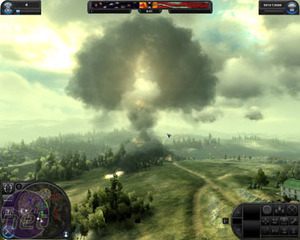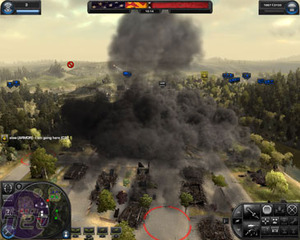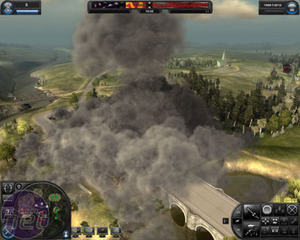
Eyes, meet OMG
So, how good does World in Conflict actually look in actual gameplay? Well, it looks good enough for me to seriously contemplate either dedicating this page only to screenshots or to various acronyms which I believe may communicate my excitement faster.Multiplayer games always start with the same awesome introduction; a high altitude plummet from above cloud level down to the standard viewing angle. At first we thought it was some lame kind of CG cutscene, then we realised that the whole thing was being rendered in the game engine. That was our first taste of how beautiful this game is and we may never forget it.
Once down on the battlefield we took a minute to assess the level, which we were able to do on two fronts thanks to the game's optional support for dual monitor set-ups in a manner similar to that used in Supreme Commander with the additional screen being filled with a top-down map of the battlefield.
The map is another great example of the graphics possible within World of Conflict because it isn’t just a picture of the terrain dotted with information of where the units are. Instead, it’s a actual top down view of the battlefield again which allows each player to not just see where various units are, but also to do see the impact and range of each and every explosion from a top down perspective. This wasn’t something we really noticed though, not until the first time we saw somebody drop a tactical nuke.

Oh, yes; the tactical nuke. You probably want to know all about that.
Well, it starts off as a brilliant white light and the first time I saw it there was nobody near my computer until I yelled out “What the hell was that?! A nuke?!” at which point even the office upstairs emptied in the mad rush to see how l33t it looked.
Once the white light fades, gameplay stops for a minute while everybody stops to turn around and look at the gargantuan pillar of smoke that issues forth from the landscape and soon extends ever upwards and outwards, engulfing large portions of the map. That might sound overly dramatic to you, but then you haven’t seen it in action. The deeply black cloud is visibly filled with flames and trying to move a camera through it is impossible because it actually does absorb light and stop you being able to see through it.
In fact, the cloud expands so high and so wide that our second screen which represented the top-down view of the level was soon filled with thick, resinous smoke that glittered with detail and deadly radiation.
In short, it was so glorious that nobody noticed when a bit of sandwich (Marmite and lettuce) fell out of my open mouth.
The smoke effects are, without the tiniest shred of doubt, the most impressive facet of World in Conflict. They just look so brain-stonkingly awesome that it’s hard to put into words. As time went on we noticed that smoke clouds do suffer from some small problems – mainly that they don’t respond to the wind caused by passing helicopters – but this is just us searching for problems to pick on. If anything, these flaws are a testament to how realistic the cloud looked and how the realism of the graphics pushed out expectations ever higher.
Some of the other super-attacks are equally impressive, such as the napalm attack which blankets a line of the landscape with beautiful, victory-flavoured fire, while other attacks such as the chemical warfare attack, which is handy for choking hordes of infantry but looks a little low-powered such an expensive indiscriminate attack.
Another feature which was impressive but still managed to leave us a little underwhelmed was the terrain deformation. In most normal gameplay it isn’t much of a problem and stray missiles or explosions will take out sizeable chunks of the landscape, leaving behind appropriately sized craters. A well-placed airstrike will even level a building, spraying physics debris up into the air and sending the whole structure down into a pile of eye-pleasing rubble.
However, some of the more massive weapons, such as the tactical nuke, illustrate problems with the terrain deformation in that the craters are often not very deep. The nuke itself sends up a cloud big enough to fill several screens, but the crater left behind is only as deep as the crater left by an air-to-surface missile and only as wide as a few artillery cannons.
Craters have obviously been left small for gameplay reasons, but in all honesty we would have rather seen gameplay have to be rebalanced than sacrifice the powerful feeling of dropping a nuclear weapon on a single infantry grunt whilst yelling “Hah! Take that, Cheezburger92!”

MSI MPG Velox 100R Chassis Review
October 14 2021 | 15:04













Want to comment? Please log in.